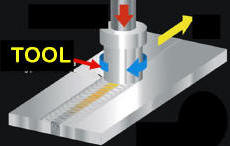ARLINGTON HEIGHTS, ILLINOIS, USA, Tuesday, March 19, 2013: Hill Tech Sales, a leader in Components for Thermal Management and Electrical Power Conversion today posted information on friction stir welding in a cold plate construction.
Recently the only way to make certain configurations of high thermally efficient aluminum cold plates was by brazing. This is where a base, fins/tubulators and cover plate are brazed together to form one complete assembly.
Most designers would choose to avoid brazing if possible because of the inherent cost and issues that arise.
- Annealing
- Wasted material
- Increased machining costs
- Internal debris
- Additional QA and testing
Annealing – When brazing is done the material is converted from its original temper, the annealing process re-creates the original hardness.
Wasted material comes about from more material being used to compensate for the distortion (warping/twisting) that occurs in brazing and post brazing annealing process. This allows the part to be machined to the original tolerances, with details and flatness required.
Increased machining costs occur because of the ability to consistently heat-treat a part. It is very difficult to accurately anneal a brazed part to a consistent hardness; the larger the part, the more difficult it becomes. This results in the machining being done at a much lower speed (increasing machine time). Why does this happen? When you run a part with inconsistent hardness through the machining center, if it is cutting through some material with a given hardness at a certain speed, and then all of a sudden hits a soft section, it will move through that material in a much more rapid and unpredictable manner, making it difficult to control machining accuracies and flatness.
Internal debris means that scrapping finished parts becomes inevitable. Debris develops and is sealed inside the part. When there is some highly detailed feature, i.e., fine fin pitches, stray material can become lodged between the fins reducing liquid flow and decreasing thermal performance in an unpredictable manner. In some cases the additional debris only becomes loose over time and the restriction becomes apparent at that future time. To avoid this, additional quality assurance tests and cleaning processes can be implemented. This again is just adding cost.
Are there other alternatives? One method is called FSW – friction stir welding. The process (welding) is done by a specially ground tool in the milling machines that create a soft “plastic” state by using the spindle speed and feed rates to control the process.
The key attribute of using FSW for heat sinks is that you are not changing the anneal of the material, so there is no need for additional annealing and eliminate the other problems that result from this process: Wasted material, Increased machining costs, Internal debris, and Additional QA testing.
In the traditional sense FSW is actually a whole lot closer to machining than welding. Once you have the proper tool, speeds & feeds, where the process control is locked down, it is a very, very, stable operation.
When considering companies to do FSW heat sinks for you, look for:
- Experience with this process – Look for a company that has done at least several hundred meters.
- Professional training – Has the personnel attended classes at the TWI training center in Cambridge, England? Do they have technical support from TWI for special projects like solid copper welding, welding solid aluminum and aluminum castings, or even dissimilar materials?
- Machining knowhow – One of the important aspects from a machining stand point is holding on to the parts during the FSW operation. The company should have experience machining aluminum for decades from very low speeds & feeds, up to speeds of 60,000 RPM, i.e. feed rates of over 350 inch/min.
For more questions on this article contact:
Andrew Hill
Hill Technical Sales
216 West Campus Drive
Arlington Heights, IL 60004
Tel: +1- 847-255-4400 ext 12 Fax: +1-847-255-0192
You may also visit: http://www.hilltech.com/


